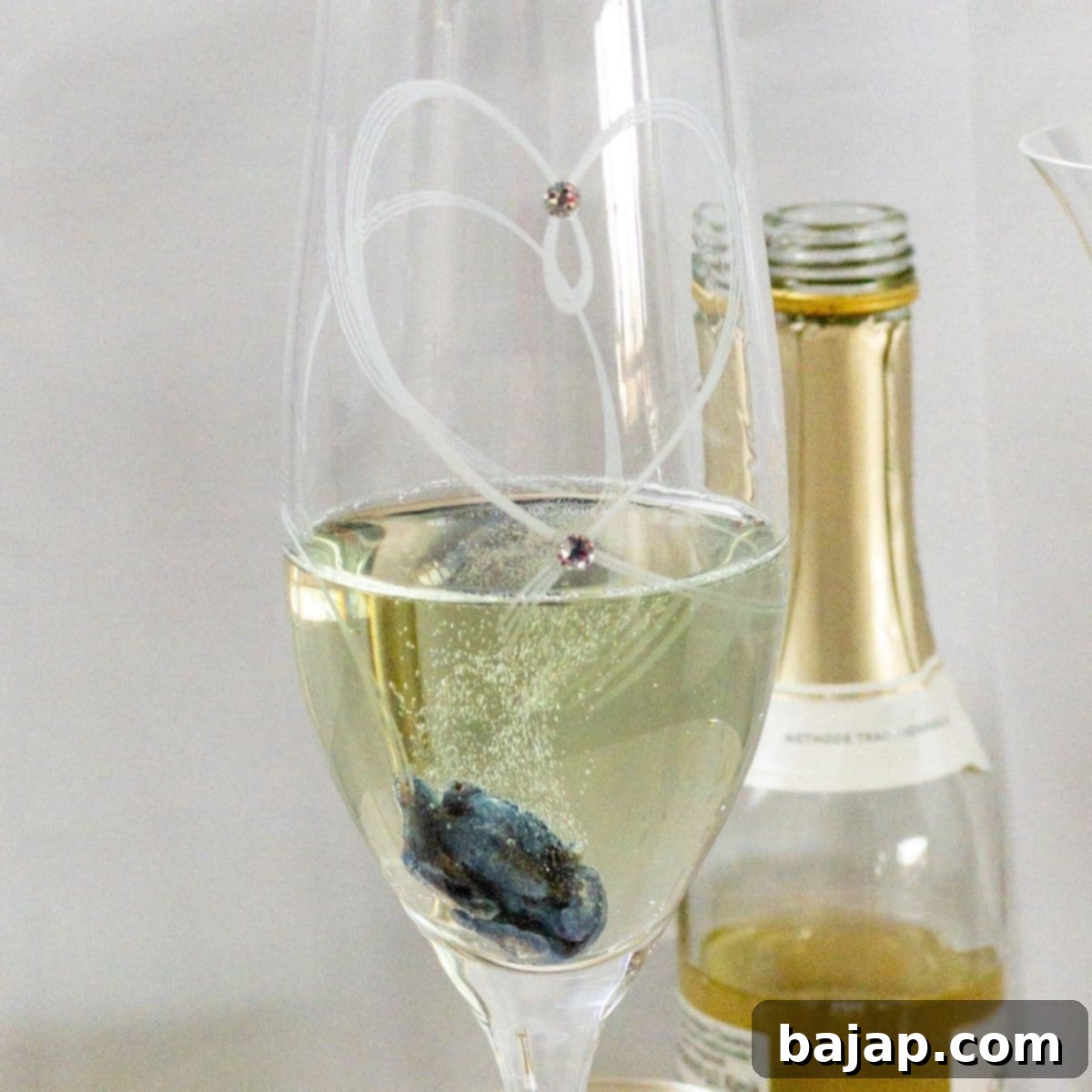Sparkling Wine with Candied Violets: An Elegant & Easy Festive Drink Recipe
Prepare to enchant your senses and elevate any gathering with this exquisite sparkling wine with candied violets. This truly festive drink is an absolute showstopper, making it ideal for a vibrant spring brunch, a sophisticated dinner party, or simply to make an impression on guests with its unique charm. Its delicate visual appeal, combined with an intoxicating aroma and a subtle, floral sweetness, promises an unforgettable experience.
The magic of this drink lies in the candied violets. As these beautiful edible flowers slowly infuse into the sparkling wine, they release a wonderfully fresh, flowery scent and a hint of sweetness that perfectly complements the effervescence. This delightful combination instantly transports you to the heart of springtime, inviting you to relax and savor every moment.
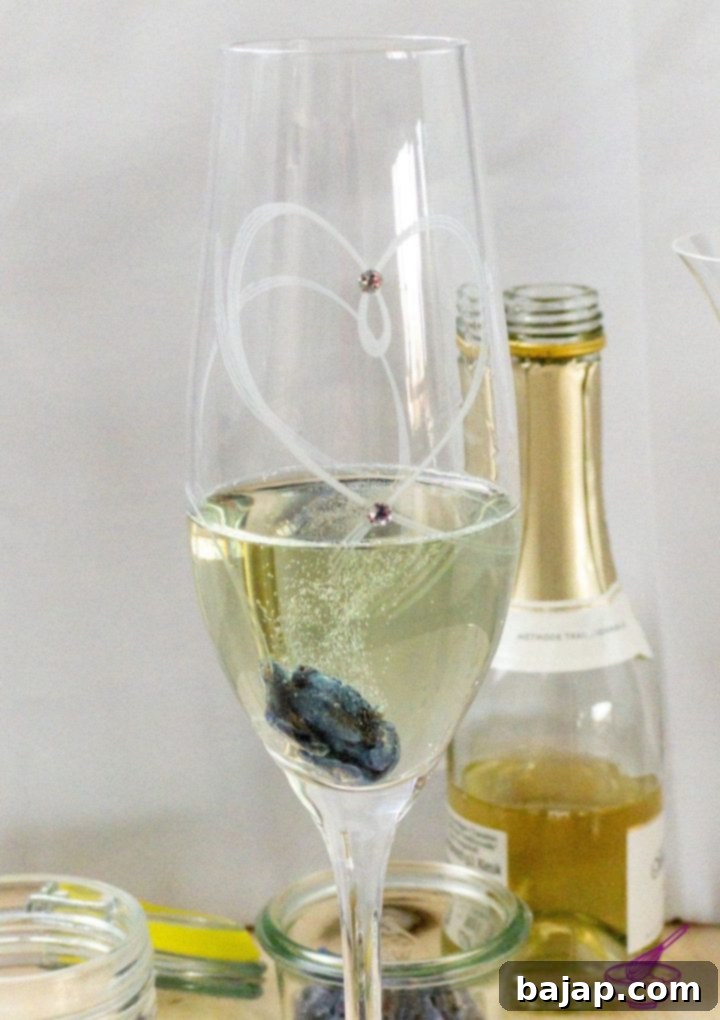
Imagine basking in the warm glow of the sun, feeling its gentle kiss on your skin, while holding a glass of this delicious treat. It’s more than just a drink; it’s an invitation to let your soul dangle and embrace the joy of the season. Try it out, and allow yourself to be utterly enchanted by its simple elegance and captivating flavors!
If you’re feeling adventurous and wish to add a personal touch, consider making your own candied violets. They are surprisingly simple to prepare and offer a unique satisfaction. For detailed instructions, check out my comprehensive blog post about: Candied Violets: Empress Sissi’s Favorite Sweet Treat. Crafting them yourself allows for control over sweetness and color, which can subtly influence your final sparkling wine creation.
🥘 Ingredients for Your Violet Sparkling Wine
This exquisite drink requires just a few high-quality ingredients to achieve its stunning effect and delicious taste. The beauty is in its simplicity, allowing the delicate floral notes to shine through.
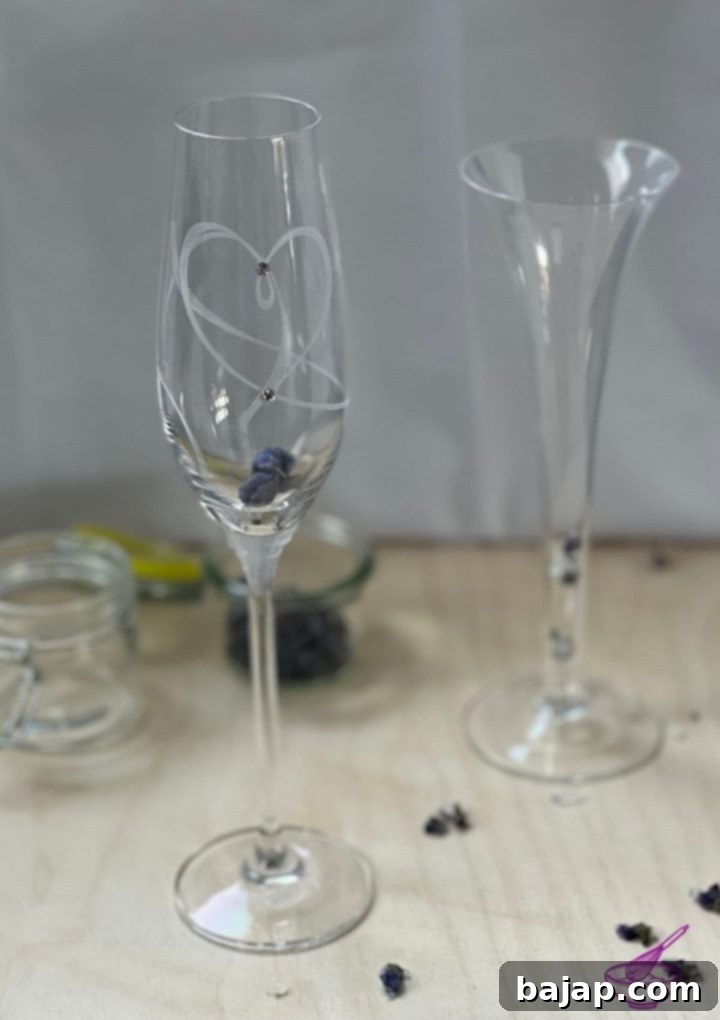
- Sparkling wine, champagne, or prosecco: The choice is yours! Each offers a slightly different profile that can complement the violets in unique ways. A dry or brut sparkling wine will allow the sweetness of the violet to stand out, while a demi-sec might enhance a sweeter floral note.
- Candied violets: These are the stars of the show! You can choose to use homemade candied violets for a truly artisanal touch and often a more natural hue, or opt for convenient store-bought candied violets for ease. Store-bought versions often have a more vibrant color and sometimes a stronger sugary coating, which can lead to a quicker, more intense color and sweetness in your drink.
See the recipe card below for exact quantities and detailed nutritional information.
🍽 Equipment Needed
Creating this elegant drink requires minimal equipment, emphasizing its simplicity and accessibility. You likely already have everything you need in your kitchen.
- Champagne flute or elegant glass: The shape of a champagne flute is ideal for showcasing the delicate violet and preserving the sparkling wine’s effervescence and aroma. Any elegant glass will do, but flutes add an extra touch of sophistication.
🔪 Instructions: Crafting Your Violet Sparkling Wine
The preparation of this delightful drink is as straightforward as it is elegant. In just a few simple steps, you’ll have a visually stunning and aromatic beverage ready to impress.
- Prepare your glasses: Depending on the number of guests you’re serving, select one or more elegant champagne glasses or flutes. The presentation is key here, so choose your best stemware!
- Add the candied violet: Carefully place a single candied violet in the bottom of each glass. You’ll notice immediately how these delicate flowers transform the glass into a miniature work of art. For illustrative purposes, I’ve prepared two champagne glasses for you: one featuring a homemade candied violet and the other with a store-bought one. This demonstrates the subtle differences in how each infuses its color and flavor.
- Pour the sparkling wine: Now, slowly and gently fill each glass approximately ⅔ full of your chosen sparkling wine, prosecco, or champagne. It’s important not to overfill the glasses. Leaving about one-third of the glass empty allows ample space for the sparkling wine’s bouquet to develop and for the captivating violet aroma to mingle with it. Remember, what we smell significantly influences our perception of taste.
- Observe the magic: As the sparkling wine touches the candied violet, the coloring process occurs very quickly. You’ll likely notice a more vital, immediate color release from store-bought violets, while homemade ones tend to offer a softer, more gradual tint.
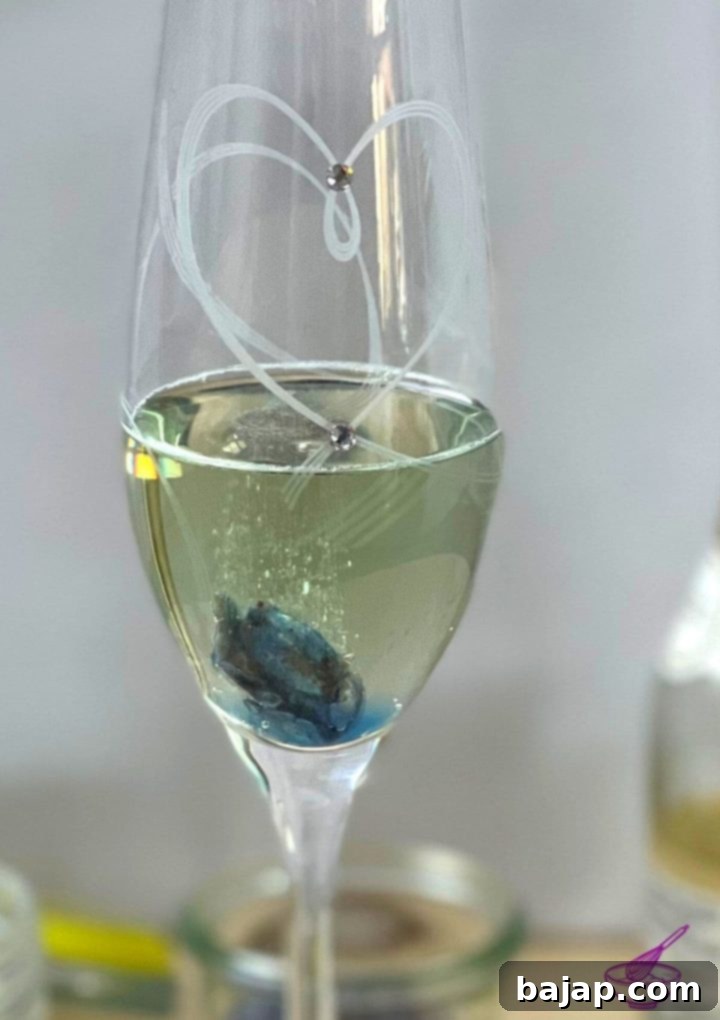
You may find that the sparkling wine with purchased candied violets is slightly sweeter but perhaps less nuanced in terms of floral taste, due to the often more intense sugar coating. Homemade violets, on the other hand, can offer a purer, more subtle violet essence.
Should you be inspired to try making your own candied violets, I highly recommend checking out my dedicated blog post. It provides easy, step-by-step instructions to guide you through the process, ensuring beautiful results that will make your violet sparkling wine truly unique.
🥂 Serving Suggestions and Perfect Pairings
This elegant drink is perfect on its own as a delightful aperitif, but it also pairs beautifully with a variety of light snacks and desserts. Consider serving it alongside delicate finger foods such as mini quiches, bruschetta, or artisanal cheese platters. For a sweeter indulgence, it complements delectable desserts like my delicious double chocolate bundt cake or delightful chocolate espresso crinkle cookies. The floral notes of the violet and the crispness of the sparkling wine cut through richness, creating a harmonious balance.
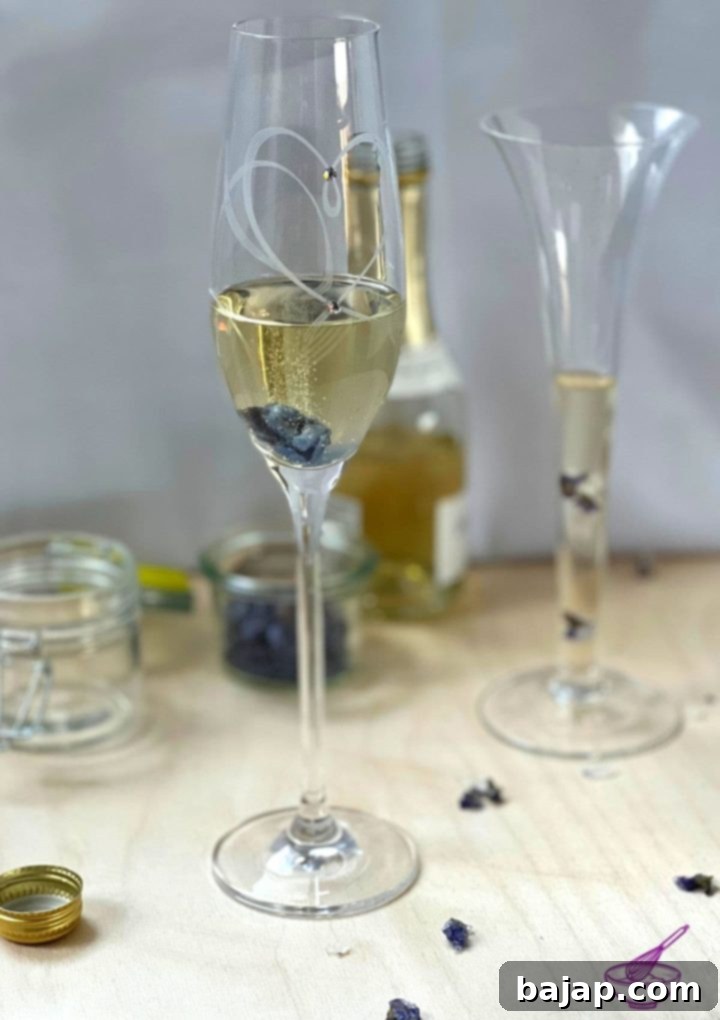
📖 Variations: Choosing Your Perfect Bubbly
The easiest and most impactful way to vary this enchanting drink is by selecting different types of “bubbly wine.” Whether you opt for sparkling wine, champagne, or prosecco, each choice will impart a distinct character to your final violet creation.
While all three fall under the umbrella of sparkling wine, there are key distinctions that can influence your drink:
- Sparkling Wine: This is the broadest category for any effervescent wine with significant levels of carbon dioxide. It can come from anywhere in the world and offers the widest range of styles and price points. A dry sparkling wine is generally recommended to allow the violet’s flavor to shine without overwhelming sweetness.
- Prosecco: Originating from Italy, Prosecco is typically made from Glera grapes using the Charmat method, which involves secondary fermentation in large steel tanks. This often results in lighter, fruitier notes (green apple, pear, honeydew) and a softer, less persistent bubble than Champagne. Its inherent sweetness and fruitiness can create a wonderfully aromatic and approachable violet drink.
- Champagne: Hailing exclusively from the Champagne region of France, this luxurious sparkling wine is made primarily from Chardonnay, Pinot Noir, and Pinot Meunier grapes using the traditional method, with secondary fermentation occurring in the bottle. Champagne generally has finer, more persistent bubbles and complex flavors, often including notes of brioche, almond, and toast. Using Champagne with candied violets creates a truly opulent and sophisticated beverage.
Understanding these differences allows you to tailor your candied violet sparkling wine to your personal preference or the occasion. A crisp Prosecco for a light brunch, a sophisticated Champagne for a celebration, or a versatile sparkling wine for everyday elegance.
Source: pediaa.com
🌡️ Storage Tips
To ensure the best enjoyment of your candied violet sparkling wine, always serve the drink cold. It’s best prepared just before serving to maintain the freshness of the bubbles and the delicate infusion of the violet. As for the candied violets themselves, store them in an airtight container in a cool, dry place to prevent them from becoming sticky or losing their crispness. This will keep them ready for your next spontaneous celebration!
💭 Top Tip: Why to Avoid Violet Syrup
While violet syrup might seem like an easy alternative for infusing violet flavor, I strongly advise against using it for this particular recipe. The primary reason is that most violet syrups possess a very strong, often artificial, and overly sweet aftertaste that can be far too intrusive. This syrup would completely overpower the delicate nuances of the sparkling wine and the natural essence of the candied violet.
This recipe is specifically designed to highlight a subtle, natural violet note that flatters and enhances the sparkling wine, rather than dominating it with excessive sweetness or artificial flavors. The goal is a harmonious blend where the floral hint acts as an elegant accent, not the main, overwhelming flavor.
If you enjoy violet syrup, consider using it for other applications, such as in more complex cocktails where its intensity can be balanced by a wider array of ingredients, or for non-alcoholic drinks where a bolder flavor is desired.
🧐 Interesting Facts About Violets
Violets are more than just pretty flowers; they have a rich history and fascinating properties that make them truly special.
When are violets in season?
The vibrant flowering season for violets mainly spans from March to May, signaling the arrival of spring. However, it’s not uncommon to stumble upon blooming specimens even in late summer, offering a delightful surprise. This extended season means you can enjoy fresh violets for various culinary and decorative purposes throughout much of the year.
Characteristics and Medicinal Uses of Violets
Beyond their beauty, violets have long been recognized for their beneficial properties in traditional medicine:
- Antibacterial: Violets contain compounds that exhibit mild antibacterial effects, historically used in poultices and infusions.
- Cough suppressant: Extracts from violets, particularly their leaves and flowers, are known for their expectorant properties, helping to soothe coughs and clear respiratory passages.
- Analgesic: They possess mild pain-relieving qualities, making them useful in remedies for headaches and minor aches.
- Soothing: Violets have a calming effect, both internally when consumed as a tea and externally when applied to irritated skin.
- Cooling: Their inherent cooling properties make them a popular ingredient in soothing balms and compresses for inflammation.
How to use violets in the kitchen
The culinary versatility of violets is truly remarkable, adding both flavor and beauty to a range of dishes:
- Syrup is easy to prepare: Violet syrup, while not recommended for this sparkling wine recipe, is a popular way to capture their flavor for other beverages, desserts, and cocktails.
- As an addition to salad: Fresh violet petals make a beautiful and subtly flavored addition to green salads, offering a touch of elegance and a hint of sweetness.
- Candied violets as cake decoration: These glittering blossoms are perfect for adorning cakes, cupcakes, and pastries, transforming simple desserts into works of art.
- Candied violets for drinks: As showcased in this recipe, they are an unparalleled garnish for sparkling wines, cocktails, and even iced teas, infusing both flavor and visual charm.
Empress Sissi and the Candied Violets: A Royal Indulgence
The allure of candied violets captivated even royalty. Empress Elisabeth of Austria, famously known as Empress Sissi, was renowned for her beauty, her strict diet, and her singular indulgence: candied violets and purple ice cream. Despite her rigorous regimen, these floral confections were her beloved exception. The imperial court supplier and confectioner Demel, located directly opposite Vienna’s Hofburg Palace, regularly provided her with these exquisite sweets, cementing their status as a luxurious delicacy.
A charming legend further intertwines Sissi with these delicate flowers: “The legend goes that once upon a time in the Prater, when a young lad discovered the first violet in bloom that year, he covered it with his hat. When Empress Sisi passed by on her daily ride, he presented her with the violet. In gratitude, Sisi gave him her riding glove.” This tale perfectly encapsulates the reverence and affection associated with violets, especially when given to such an esteemed figure.
If you make this recipe, let me know how you liked it by giving it a ★★★★★ star rating and leaving a comment below. Your feedback is truly awesome! You can also sign up for our Newsletter to receive weekly delicious homemade recipes, or follow me on Pinterest or Instagram and share your creation with me. Just tag me @combinegoodflavors and hashtag #combinegoodflavors, so I don’t miss it!
📖 Recipe Card: Candied Violets with Sparkling Wine
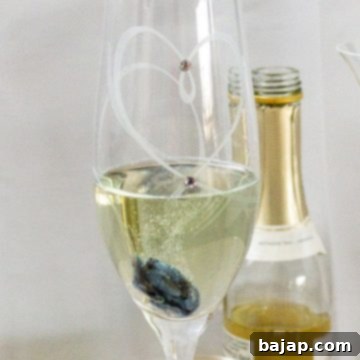
Candied Violets with Sparkling Wine
By Nora
Prevent your screen from going dark
Save Recipe
Saved!
Pin Recipe
5 minutes
5 minutes
Cocktails, Drinks
Austrian
2
Glasses
98
kcal
Equipment
-
2 Champagne flutes
Ingredients
-
2
Candied violets -
1 ⅔
cups
Sparkling wine, divided
Instructions
-
Place one of 2 Candied violets in each of the two glasses.2 Candied violets
-
Fill each glass approximately ⅔ full with 1 ⅔ cups Sparkling wine, divided, prosecco, or champagne.1 ⅔ cups Sparkling wine, divided
-
Enjoy your beautiful and delicious violet sparkling wine!
Never miss a recipe!
Sign up and let me spoil you weekly with a delicious homemade recipe!
Candied Violets, candied violets drink, candied violets queen elizabeth, candied violets with sparkling wine, candied violets with sparkling wine recipe
Like this recipe?
Mention @combinegoodflavors or tag #combinegoodflavors!
Nutrition values are estimates only, using online calculators. Please verify using your own data.
Serving:
1
Glass
|
Calories:
98
kcal
|
Carbohydrates:
2
g
|
Protein:
1
g
|
Sodium:
14
mg
|
Potassium:
176
mg
|
Sugar:
2
g
|
Vitamin A:
3
IU
|
Calcium:
18
mg
|
Iron:
1
mg

🤎 You might also like
If you enjoyed crafting this elegant drink, you might also be interested in other delightful recipes to further explore unique flavors and festive beverages:
- How to make Candied Violets
- French Press Eggnog Coffee Recipe
- How to make a Snowball Cocktail
- Stracciatella egg liqueur milkshake recipe
⛑️ Food Safety Guidelines
Ensuring food safety is paramount when preparing any culinary delight. Please observe the following general guidelines to ensure a safe and enjoyable experience:
- Cook to a minimum temperature of 165 °F (74 °C) for dishes involving meat or eggs, if applicable. While this recipe doesn’t involve cooking, it’s a good general practice.
- Do not use the same utensils on cooked food that previously touched raw meat or unwashed produce.
- Always wash hands thoroughly after touching raw meat, unwashed ingredients, or before handling prepared food.
- Don’t leave perishable food sitting out at room temperature for extended periods, especially during warm weather.
- Never leave cooking food unattended on the stovetop or in the oven.
- When cooking, use oils with a high smoking point to avoid the formation of harmful compounds.
- Always ensure good ventilation when using a gas stove or oven to prevent the buildup of harmful fumes.
For further comprehensive information on safe food handling practices, please check the official Safe Food Handling – FDA guidelines.
